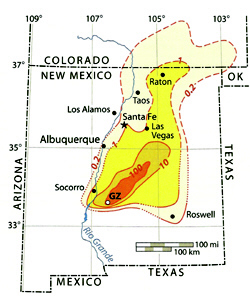Answer to Question #9593 Submitted to "Ask the Experts"
Category: Other
The following question was answered by an expert in the appropriate field:
I lived in St. Johns, Arizona, from 1936 to 1955. St. Johns is located in the northeastern part of Arizona and is the county seat of Apache County. Is it possible that there was radioactive fallout from the Trinity Site in New Mexico on 16 July 1945 that reached this area of eastern Arizona? As a young girl I vividly recall the early morning hours of that blast and the sounds of what almost seemed to be a big gust of wind.
This is an interesting question and it actually raises two issues: (1) could any fallout from the test have reached you, and (2) if it did, could it have caused harm?
For the first question, there are two ways that anyone might have been exposed—radiation from the test explosion itself and fallout. You were located so far from the test site that I think it's safe to say that you received hardly any radiation at all from the blast itself—I'm sure we could calculate a number, but I'm also certain that it would be a lot less than from any x ray you've had or from any plane flight you've taken. This is because radiation dose rate drops off so quickly as you move away from any source—even an explosion. Anyone more than 16 kilometers (km) or so away just wouldn't be close enough to receive a high level of radiation exposure. In addition, see the map below of fallout from the test and notice that the fallout all went to the northeast—almost directly the opposite direction from your location—which is the direction of the prevailing winds. So I think it's very safe to say that you were likely not exposed to radiation from either the blast itself or from fallout.

Since the answer to the first question is that you were likely not exposed to any fallout and probably only very, very low levels of any other kind of radiation, that means the answer to the second question is that I really wouldn't expect to see any health effects at all. There have been numerous studies of people who were exposed to elevated levels of radiation from their jobs (pilots and flight crews, nuclear submarine crews, radiologists, nuclear power plant workers) and most of these studies show that these workers don't have higher incidences of cancer when compared to other groups with similar working conditions and health plans (but no radiation exposure). In addition, it's sort of interesting to see that the Rocky Mountain states, where natural radiation levels are highest, seem to have fewer cancers than lower-elevation states with a lower radiation dose. To me, all of this means that whatever radiation you might have received from the test would have been so attenuated by the distance that it just isn't capable of causing any problems.
P. Andrew Karam, PhD, CHP
* The measurement units are given here in mR h-1 (called traditional units) because they are the units used by the authors of the research. However, the Health Physics Society has adopted the SI (International System) of units; 1 mR is equal to 2.58 × 10-7 coulomb per kg (C kg-1) in SI.


